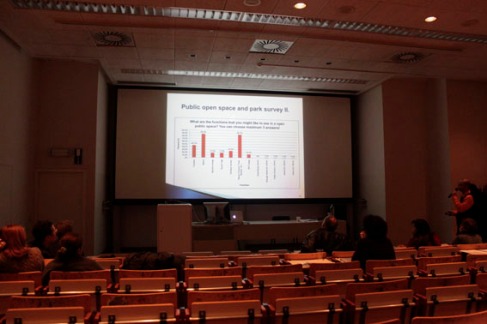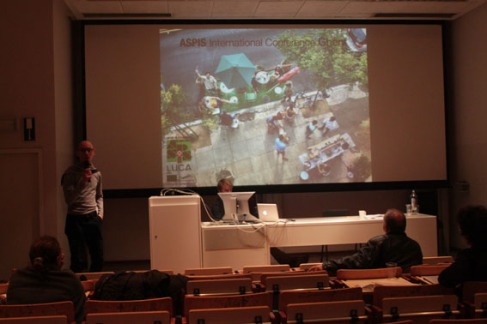ASPIS Conference Gent(BE)_Live Reporting: Day 02(PM)
End of the ASPIS Conference here in Gent (BE) 2012.
We want to thank again all people involved in the conference. A special thanks goes out to the students and professors of Luca for the smooth running of the conference. We wish all the people a save trip home. But first a coffee and some discussion.
Here are this afternoon’s summaries:
Livia de Bethune: Participation in public space projects in Brussels, some casestudie
Livia de Bethune makes us aware how important and interesting it can be to design a public space in collaboration with the local inhabitants. The idea is to discuss with the inhabitants from the beginning of the design all the way through until the proposal is finished. They work on their proposal and in different stages they show their progression in different media (models, plans,…). The collaboration can go from games for youth to neighbourhood walks with the inhabitants. Also they try to present projects from students to give creative ideas for different areas in Brussels.
Meriç Demir: The spatial organisation of public spaces in terms of communication and urban public life
Meriç Demir explains the definition and etymology of the term communication, communication is the way in which people come to possess things in common and has two roles: a spatial role and an instrumental role. Unfortunately the private is becoming oversized and this undermines the urban public life. She ends her talk with the following statement for thought: “the spaces that do not belong to anyone change into the spaces that belong to everyone.”
Stefanie Cornut: Building with society – Architecture as an instrument to affect social change
Stefanie presents her masters’ thesis dealing with social sustainability in Brussels. Everyone has the right to shelter, the aim is to design a home for people but also a place in society. ‘Familiar strangers’ are people you do not necessarily know but you do recognise. Place attachment is an important concept: not trying to achieve social cohesion but finding ways that people can live together through sharing the same space. The idea is to create a variety of dwellings with more shared and communal spaces, encouraging people to spend time in public space, “architecture is not only about shaping space, but also about creating place.”
Laszlo Jona: Aspects of utilization and sustainability in a public space – a Hungarian example
Batthyay square: a park and a square, in the city centre of Gyor with public institutions around it, shopping centres and university. In the past (around 1849) Batthyay was a military point. Today the place has a lot of problems: not well maintained, the public lavatory is closed, a lot of rubbish, football field in bad conditions, forbidden to smoke but everybody does. After some analysis last year, Lazslo found out that the park has a good pedestrian traffic and that they need a bicycle path and a dog running field. Finally, the big problems in the square come from poor maintenance but this can be solved by the people deciding how they will use the square in the future.
International Master of Architecture Students II: ROJM EXtended, a design studio report
INTERNATIONAL STUDENTS_GROUP#3
Each member is in a different group in the design studio and they decided to look at what they all had in common in current design task at the Tinelsite. Five central themes came up: flexibility, comfort zones, borders and boundaries, visuality and social interaction. Through these themes, which are all related, the students try to give a few main principles through sketches and diagrams from the design studio. In this way the students try to give their insight on how public space relates to its environment socially and in a sustainable way.
INTERNATIONAL STUDENTS_GROUP#4
This group of students presents their book of proceedings and the way they achieved it in the days leading up to the conference.
Here are some photos:






